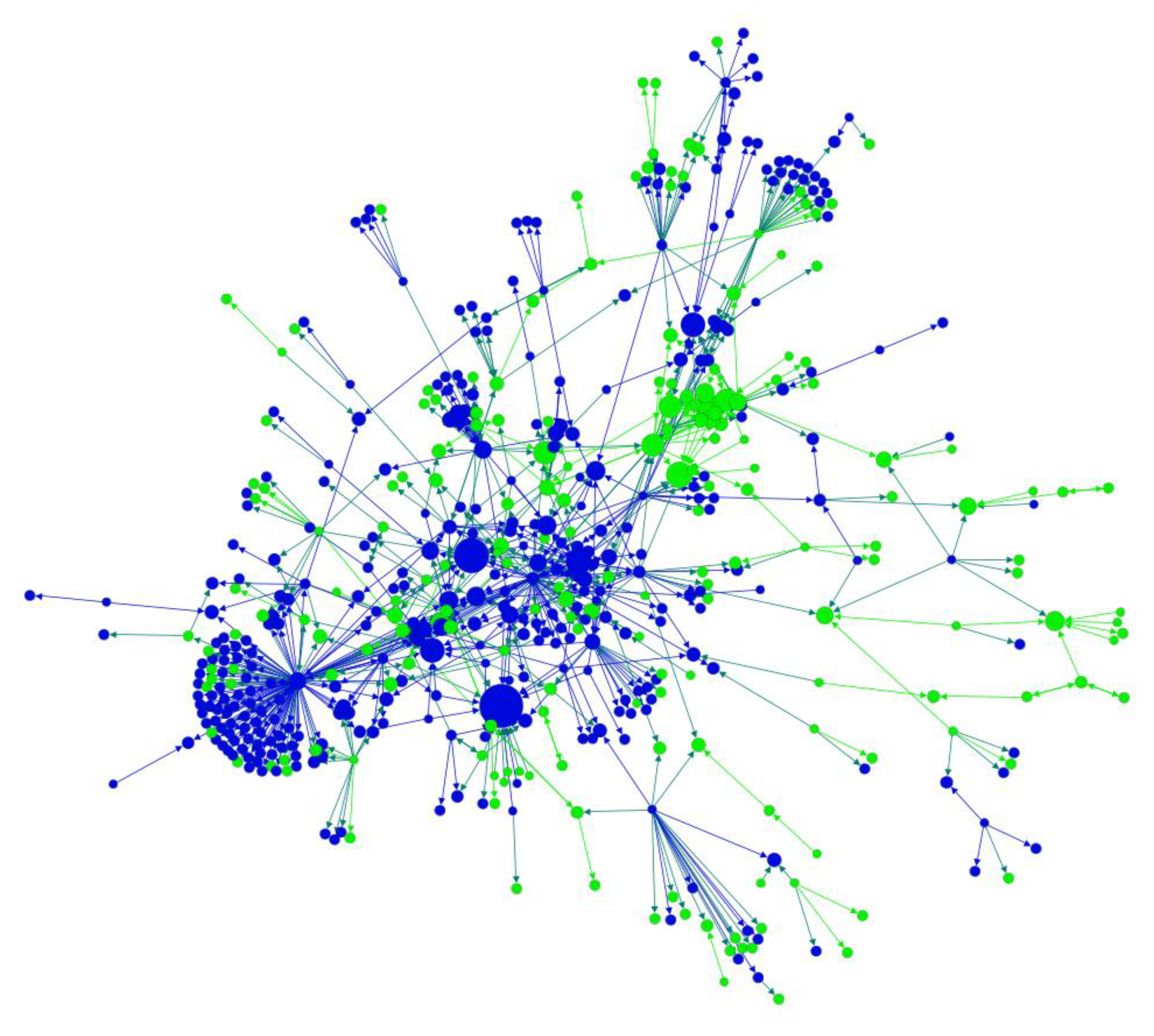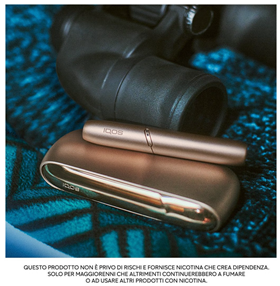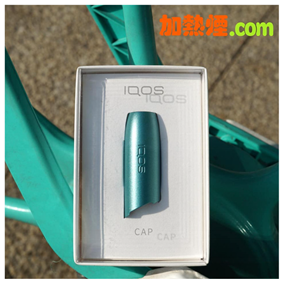An Investigation of Influential Users in the Promotion and Marketing of Heated Tobacco Products on Instagram: A Social Network Analysis
Abstract
:1. Introduction
2. Materials and Methods
3. Results
3.1. User Characteristics
3.2. Social Network Analysis
3.3. Descriptive Analysis
4. Discussion
5. Conclusions
Author Contributions
Funding
Institutional Review Board Statement
Informed Consent Statement
Data Availability Statement
Conflicts of Interest
References
- Caputi, T.L. Industry watch: Heat-not-burn tobacco products are about to reach their boiling point. Tob. Control 2017, 26, 609–610. [Google Scholar] [CrossRef] [PubMed]
- Tabuchi, T.; Gallus, S.; Shinozaki, T.; Nakaya, T.; Kunugita, N.; Colwell, B. Heat-not-burn tobacco product use in Japan: Its prevalence, predictors and perceived symptoms from exposure to secondhand heat-not-burn tobacco aerosol. Tob. Control 2018, 27, e25–e33. [Google Scholar] [CrossRef] [PubMed] [Green Version]
- Grand View Research. Heated Tobacco Products Market Size, Share & Trends Analysis Report by Component (Capsules, Heating Module, Sticks, Vaporizers), by Distribution Channel, by Region, and Segment Forecasts, 2020–2027. 2020. Available online: https://www.grandviewresearch.com/industry-analysis/heat-not-burn-market (accessed on 6 December 2021).
- Glantz, S.A. Heated tobacco products: The example of IQOS. Tob. Control 2018, 27 (Suppl. 1), s1–s6. [Google Scholar] [CrossRef] [PubMed] [Green Version]
- Bialous, S.A.; Glantz, S.A. Heated tobacco products: Another tobacco industry global strategy to slow progress in tobacco control. Tob. Control 2018, 27 (Suppl. 1), s111–s117. [Google Scholar] [CrossRef] [Green Version]
- Chun, L.; Moazed, F.; Matthay, M.; Calfee, C.; Gotts, J. Possible hepatotoxicity of IQOS. Tob. Control 2018, 27 (Suppl. 1), s39–s40. [Google Scholar] [CrossRef] [Green Version]
- Moazed, F.; Chun, L.; Matthay, M.A.; Calfee, C.S.; Gotts, J. Assessment of industry data on pulmonary and immunosuppressive effects of IQOS. Tob. Control 2018, 27 (Suppl. 1), s20–s25. [Google Scholar] [CrossRef]
- Nabavizadeh, P.; Liu, J.; Havel, C.M.; Ibrahim, S.; Derakhshandeh, R.; Iii, P.J.; Springer, M.L. Vascular endothelial function is impaired by aerosol from a single IQOS HeatStick to the same extent as by cigarette smoke. Tob. Control 2018, 27 (Suppl. 1), s13–s19. [Google Scholar] [CrossRef] [Green Version]
- St.Helen, G.; Iii, P.J.; Nardone, N.; Benowitz, N.L. IQOS: Examination of Philip Morris International’s claim of reduced exposure. Tob. Control 2018, 27 (Suppl. 1), s30–s36. [Google Scholar] [CrossRef]
- Paumgartten, F. Heat-not-burn and electronic cigarettes: Truths and untruths about harm reduction. Rev. Assoc. Med. Bras. (1992) 2018, 64, 104–105. [Google Scholar] [CrossRef] [Green Version]
- Farsalinos, K.E.; Yannovits, N.; Sarri, T.; Voudris, V.; Poulas, K. Nicotine delivery to the aerosol of a heat-not-burn tobacco product: Comparison with a tobacco cigarette and e-cigarettes. Nicotine Tob. Res. 2018, 20, 1004–1009. [Google Scholar] [CrossRef]
- Kim, M.; Watkins, S.L.; Koester, K.A.; Mock, J.; Kim, H.C.; Olson, S.; Harvanko, A.T.; Ling, P.M. Unboxed: US young adult tobacco users’ responses to a new heated tobacco product. Int. J. Environ. Res. Public Health 2020, 17, 8108. [Google Scholar] [CrossRef]
- O’Brien, E.K.; Hoffman, L.; Navarro, M.A.; Ganz, O. Social media use by leading US e-cigarette, cigarette, smokeless tobacco, cigar and hookah brands. Tob. Control 2020, 29, e87–e97. [Google Scholar] [CrossRef]
- Freeman, B.; Chapman, S. British American Tobacco on Facebook: Undermining article 13 of the global World Health Organization Framework Convention on Tobacco Control. Tob. Control 2010, 19, e1–e9. [Google Scholar] [CrossRef]
- Huang, J.; Kornfield, R.; Szczypka, G.; Emery, S.L. A cross-sectional examination of marketing of electronic cigarettes on Twitter. Tob. Control 2014, 23 (Suppl. 3), iii26–iii30. [Google Scholar] [CrossRef] [Green Version]
- Emery, S.L.; Vera, L.; Huang, J.; Szczypka, G. Wanna know about vaping? Patterns of message exposure, seeking and sharing information about e-cigarettes across media platforms. Tob. Control 2014, 23 (Suppl. 3), iii17–iii25. [Google Scholar] [CrossRef] [Green Version]
- Payne, J.D.; Orellana-Barrios, M.; Medrano-Juarez, R.; Buscemi, D.; Nugent, K. Electronic Cigarettes in the Media. Bayl. Univ. Med. Cent. Proc. 2016, 29, 280–283. [Google Scholar] [CrossRef] [Green Version]
- Paek, H.-J.; Kim, S.; Hove, T.; Huh, J.Y. Reduced harm or another gateway to smoking? Source, message, and information characteristics of E-cigarette videos on YouTube. J. Health Commun. 2014, 19, 545–560. [Google Scholar] [CrossRef]
- Czaplicki, L.; Kostygina, G.; Kim, Y.; Perks, S.N.; Szczypka, G.; Emery, S.L.; Vallone, D.; Hair, E.C. Characterising JUUL-related posts on Instagram. Tob. Control 2020, 29, 612–617. [Google Scholar] [CrossRef]
- Barker, J.O.; Vassey, J.; Chen-Sankey, J.C.; Allem, J.P.; Cruz, T.B.; Unger, J.B. Categorizing IQOS-Related Twitter Discussions. Int. J. Environ. Res. Public Health 2021, 18, 4836. [Google Scholar] [CrossRef]
- The Campaign for Tobacco-Free Kids. Over 125 Organizations Call on Social Media Companies to End all Tobacco Advertising, Including by Paid Influencers. 2019. Available online: https://www.tobaccofreekids.org/press-releases/2019_05_21_socialmedia_advertising (accessed on 6 December 2021).
- The Campaign for Tobacco-Free Kids. New Facebook/Instagram Policy on Tobacco Marketing Must be Immediately Implemented and Strictly Enforced. 2019. Available online: https://www.tobaccofreekids.org/press-releases/2019_12_18_facebook_instagram_marketing_policy (accessed on 6 December 2021).
- Kreitzberg, D.S.; Murthy, D.; Loukas, A.; Pasch, K.E. Heat-not-burn tobacco promotion on instagram. Addict. Behav. 2019, 91, 112–118. [Google Scholar] [CrossRef]
- Hejlová, D.; Schneiderová, S.; Klabíková Rábová, T.; Kulhánek, A. Analysis of Presumed IQOS Influencer Marketing on Instagram in the Czech Republic in 2018–2019. Adiktologie 2019, 19, 7–15. [Google Scholar] [CrossRef]
- Vassey, J.; Metayer, C.; Kennedy, C.J.; Whitehead, T.P. # Vape: Measuring e-cigarette influence on Instagram with deep learning and text analysis. Front. Commun. 2020, 4, 75. [Google Scholar] [CrossRef] [Green Version]
- Instaloader v4.8.2. 2021. Available online: https://instaloader.github.io/contributing.html (accessed on 4 May 2021).
- Nobles, A.L.; Leas, E.C.; Latkin, C.A.; Dredze, M.; Strathdee, S.A.; Ayers, J.W. # HIV: Alignment of HIV-related visual content on instagram with public health priorities in the US. AIDS Behav. 2020, 24, 2045–2053. [Google Scholar] [CrossRef]
- Langdetect v1.0.9. Available online: https://pypi.org/project/langdetect/ (accessed on 30 September 2021).
- Instagram. Get Your Business Started on Instagram. Available online: https://business.instagram.com/getting-started (accessed on 6 December 2021).
- Hawe, P.; Webster, C.; Shiell, A. A glossary of terms for navigating the field of social network analysis. J. Epidemiol. Community Health 2004, 58, 971–975. [Google Scholar] [CrossRef]
- Bastian, M.; Heymann, S.; Jacomy, M. Gephi: An open source software for exploring and manipulating networks. In Proceedings of the International AAAI Conference on Weblogs and Social Media, San Jose, CA, USA, 17–20 May 2009. [Google Scholar]
- Costello, C.D. “Hello? Are You Still There?” The Impact of Social Media on Self-Disclosure and Reciprocity in Interpersonal Relationships: A Literature Review. Channels Where Discip. Meet 2018, 2, 3. [Google Scholar] [CrossRef] [Green Version]
- The Campaign for Tobacco-Free Kids. IQOS Social Media Examples. 2019. Available online: https://www.tobaccofreekids.org/media/2019/iqos-marketing (accessed on 6 December 2021).
- Instagram Help Center. Edit Your Business Information on Instagram. Available online: https://help.instagram.com/529483457260403 (accessed on 6 December 2021).
- Instagram Business Categories: The Complete Guide. Available online: https://boosted.lightricks.com/instagram-business-categories-the-complete-guide/ (accessed on 6 December 2021).
- Instagram Is Testing Geo-Restriction for Stories and Posts. Available online: https://thenextweb.com/news/instagram-is-testing-geo-restriction-for-stories-and-posts (accessed on 6 December 2021).

| Account Characteristics | N (%) |
|---|---|
| Number of IQOS posts | |
| 1 post | 3280 (72.5) |
| 2–4 posts | 723 (16.0) |
| 5–9 posts | 207 (4.6) |
| 10–50 posts | 278 (6.1) |
| 50–100 posts | 27 (0.6) |
| >100 posts | 11 (0.2) |
| Number of followers a | |
| Normal | 3390 (74.9) |
| Nano | 983 (21.7) |
| Micro | 126 (2.8) |
| Mid-tier | 25 (0.6) |
| Macro | 2 (0.0) |
| Business account b | |
| Yes | 1903 (42.1) |
| No | 2623 (58.0) |
| Business category | |
| Personal Goods and General Merchandise Stores | 1110 (59.0) |
| Creators and Celebrities | 341 (18.1) |
| Home Services | 92 (4.9) |
| Restaurants | 64 (3.4) |
| General Interest | 44 (2.3) |
| Others c | 232 (12.2) |
| Verified account d | |
| Yes | 6 (0.1) |
| No | 4520 (99.9) |
| Primary language e | |
| Japanese | 1322 (29.2) |
| English | 888 (19.6) |
| Italian | 630 (13.9) |
| Russian | 518 (11.4) |
| Others | 1168 (25.8) |
| Graph Metric | Whole Network | Largest Component |
|---|---|---|
| Nodes | 4526 | 532 |
| Isolated nodes | 3714 | 0 |
| Directed edges | 1082 | 829 |
| Connected components | 98 | 1 |
| Graph density | 0.004 | 0.006 |
| Average degree | 1.333 | 1.558 |
| Average clustering coefficient | 0.171 | 0.181 |
| Degree Centrality | No. of Posts | No. of Followers | Business Account | “iqos” in Username |
|---|---|---|---|---|
| In-degree | ||||
| 0.02466 | 26 | 41,109 | Yes | Yes |
| 0.01849 | 72 | 11,470 | Yes | Yes |
| 0.01233 | 11 | 623 | No | No |
| 0.01233 | 49 | 1157 | Yes | Yes |
| 0.01110 | 4 | 1300 | Yes | No |
| Out-degree | ||||
| 0.14920 | 8 | 224 | Yes | Yes |
| 0.06782 | 3 | 257 | Yes | Yes |
| 0.03576 | 2 | 583 | No | No |
| 0.02959 | 16 | 446 | Yes | No |
| 0.02959 | 1 | 3658 | No | No |
| Betweenness | ||||
| 0.00799 | 49 | 1157 | Yes | Yes |
| 0.00437 | 3 | 257 | Yes | Yes |
| 0.00330 | 1 | 3658 | No | No |
| 0.00266 | 19 | 1546 | Yes | Yes |
| 0.00260 | 1 | 140,628 | No | No |
| Closeness | ||||
| 0.03094 | 72 | 11,470 | Yes | Yes |
| 0.02984 | 26 | 41,109 | Yes | Yes |
| 0.02436 | 49 | 1157 | Yes | Yes |
| 0.02270 | 11 | 623 | No | No |
| 0.02234 | 5 | 365 | Yes | Yes |
| Category | Characteristics | Example Post |
|---|---|---|
| IQOS-associated (N = 6) | IQOS Instagram account representing a country/region; IQOS retailer and reseller stores; IQOS case/skin service provider |  |
| Tobacco-associated (N = 5) | IQOS or other general tobacco products retailer, tobacco product service provider |  |
| Others a (N = 2) | Celebrity and social media influencers |  |
Publisher’s Note: MDPI stays neutral with regard to jurisdictional claims in published maps and institutional affiliations. |
© 2022 by the authors. Licensee MDPI, Basel, Switzerland. This article is an open access article distributed under the terms and conditions of the Creative Commons Attribution (CC BY) license (https://creativecommons.org/licenses/by/4.0/).
Share and Cite
Gu, J.; Abroms, L.C.; Broniatowski, D.A.; Evans, W.D. An Investigation of Influential Users in the Promotion and Marketing of Heated Tobacco Products on Instagram: A Social Network Analysis. Int. J. Environ. Res. Public Health 2022, 19, 1686. https://doi.org/10.3390/ijerph19031686
Gu J, Abroms LC, Broniatowski DA, Evans WD. An Investigation of Influential Users in the Promotion and Marketing of Heated Tobacco Products on Instagram: A Social Network Analysis. International Journal of Environmental Research and Public Health. 2022; 19(3):1686. https://doi.org/10.3390/ijerph19031686
Chicago/Turabian StyleGu, Jiayan, Lorien C. Abroms, David A. Broniatowski, and W. Douglas Evans. 2022. "An Investigation of Influential Users in the Promotion and Marketing of Heated Tobacco Products on Instagram: A Social Network Analysis" International Journal of Environmental Research and Public Health 19, no. 3: 1686. https://doi.org/10.3390/ijerph19031686
APA StyleGu, J., Abroms, L. C., Broniatowski, D. A., & Evans, W. D. (2022). An Investigation of Influential Users in the Promotion and Marketing of Heated Tobacco Products on Instagram: A Social Network Analysis. International Journal of Environmental Research and Public Health, 19(3), 1686. https://doi.org/10.3390/ijerph19031686







